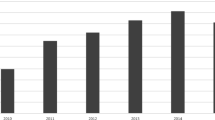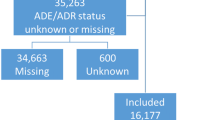Abstract
The prevalence of important adverse drug combinations was studied among the 37,367 cases included in the Finnish post-mortem toxicology database during 2000–2006. The new SFINX interaction database (Swedish, Finnish, INteraction X-referencing) was utilised to identify adverse drug combinations. Consequently, the 24 drugs chosen for the study generated 96 two-compound combinations possessing potentially severe interactions. The total number of hits for the combinations found in the post-mortem database was 267, which accounts for approximately 0.71% of all cases. The potential role of adverse drug interaction (ADI) in these cases was evaluated from the background information and death certificate. The possible ADI cases comprised 23% of all hits and 0.17% of all cases analysed. In cases with a pharmacodynamic mechanism, the most prominent combinations were medicines causing serotonin syndrome or a β1-blocker with verapamil or diltiazem. In cases with a pharmacokinetic mechanism, half of the cases involved digoxin in combination with verapamil. In one third of the possible ADI cases, a forensic pathologist had noted the studied compounds as an underlying or contributing cause of death, although the agents’ specific role in ADIs was rarely recognised.
Similar content being viewed by others
References
Beijer HJM, de Blaey CJ (2002) Hospitalisations caused by adverse drug reactions (ADR): a meta-analysis of observational studies. Pharm World Sci 24:46–54
Mozayani A, Raymon LP (eds) (2003) Handbook of drug interactions. A clinical and forensic guide. Humana, Totowa, NJ
Baxter K (ed) (2005) Stockley’s drug interactions, 7th edn. Pharmaceutical Press, London, UK
Lampela P, Hartikainen S, Sulkava R, Huupponen R (2007) Adverse drug effects in elderly people—a disparity between clinical examination and adverse effects self-reported by the patient. Eur J Clin Pharmacol 63:509–515
Öhberg A, Vuori E, Ojanperä I, Lönnqvist J (1996) Alcohol and drugs in suicides. Br J Psychiatry 169:75–80
Indermitte J, Erba L, Beutler M, Bruppacher R, Haefeli WE, Hersberger KE (2007) Management of potential drug interactions in community pharmacies: a questionnaire-based survey in Switzerland. Eur J Clin Pharmacol 63:297–305
Drummer OH (2007) Requirements for bioanalytical procedures in postmortem toxicology. Anal Bioanal Chem 388:1495–1503
Druid H, Holmgren P (1997) A compilation of fatal and control concentrations of drugs in post-mortem femoral blood. J Forensic Sci 42:79–87
Reis M, Aamo T, Ahlner J, Druid H (2007) Reference concentrations of antidepressants. A compilation of postmortem and therapeutic levels. J Anal Toxicol 31:254–264
Koski A, Ojanperä I, Vuori E (2002) Alcohol and benzodiazepines in fatal poisonings. Alcohol Clin Exp Res 26:956–959
Koski A, Ojanperä I, Vuori E (2003) Interaction of alcohol and drugs in fatal poisonings. Hum Exp Toxicol 22:281–287
Koski A, Vuori E, Ojanperä I (2005) Relation of postmortem blood alcohol and drug concentrations in fatal poisonings involving amitriptyline, propoxyphene and promazine. Hum Exp Toxicol 24:389–396
Koski A, Vuori E, Ojanperä I (2005) Newer antidepressants: evaluation of fatal toxicity index and interaction with alcohol based on Finnish postmortem data. Int J Legal Med 119:344–348
Vuori E, Ruohonen A, Penttilä A, Klaukka T, Lahti T (1989) Fatal poisonings with antidepressants in Finland 1985–1987. Acta Psychiatr Scand Suppl 354:55–60
Buckley NA, McManus PR (2002) Fatal toxicity of serotonergic and other antidepressant drugs: analysis of United Kingdom mortality data. BMJ 325:1332–1333
Cheeta S, Schifano F, Oyefeso A, Webb L, Ghodse AH (2004) Antidepressant-related deaths and antidepressant prescriptions in England and Wales, 1998–2000. Br J Psychiatry 184:41–47
Hoiseth G, Bramness JG, Christophersen AS, Morland J (2007) Carisoprodol intoxications: a retrospective study of forensic autopsy material from 1992–2003. Int J Legal Med 121:403–409
Strandell J, Bate A, Lindquist M, Edwards IR, The Swedish, Finnish, INteraction X-referencing Drug–Drug Interaction Database (the SFINX group) (2008) Drug–drug interactions—a preventable patient safety issue? Br J Clin Pharmacol 65:144–146
Vuori E, Ojanperä I, Nokua J, Ojansivu RL (2006) Oikeuskemiallisesti todetut myrkytyskuolemat Suomessa vuosina 2002–2004. Suomen lääkärilehti (Finnish Medical Journal) 61:2339–2344 (in Finnish, English summary: fatal poisonings in Finland 2002–2004)
Schulz M, Schmoldt A (2003) Therapeutic and toxic blood concentrations of more than 800 drugs and other xenobiotics. Pharmazie 58:447–474
Jack DB (ed) (1992) Handbook of clinical pharmacokinetic data. Macmillan, London, UK
The International Association of Forensic Toxicologists (TIAFT) (2008) Therapeutic and toxic drug concentrations. Available at: http://www.tiaft.org/tmembers/ttvidx.html
Jones AW, Holmgren P (2003) Comparison of blood–ethanol concentration in deaths attributed to acute alcohol poisoning and chronic alcoholism. J Forensic Sci 48:874–879
Chen YF, Avery AJ, Neil KE, Johnson C, Dewey ME, Stockley IH (2005) Incidence and possible causes of prescribing potentially hazardous/contraindicated drug combinations in general practice. Drug Saf 28:67–80
Peng CC, Glassman PA, Marks IR, Fowler C, Castiglione B, Good CB (2003) Retrospective drug utilization review: incidence of clinically relevant potential drug–drug interactions in a large ambulatory population. J Manag Care Pharm 9:513–522
Åstrand B, Åstrand E, Antonov K, Petersson G (2006) Detection of potential drug interactions—a model for a national pharmacy register. Eur J Clin Pharmacol 62:749–756
Gronroos PE, Irjala KM, Huupponen RK, Scheinin H, Forsstrom J, Forsstrom JJ (1997) A medication database—a tool for detecting drug interactions in hospital. Eur J Clin Pharmacol 53:13–17
Reynaud M, Petit G, Potard D, Courty P (1998) Six deaths linked to concomitant use of buprenorphine and benzodiazepines. Addiction 93:1385–1392
Levy RH, Thummel KE, Trager WF, Hansten PD, Eichelbaum M (eds) (2000) Metabolic drug interactions. Lippincott Williams & Wilkins, Philadelphia, PA
Sternbach H (1991) The serotonin syndrome. Am J Psychiatry 148:705–713
Neuvonen PJ, Pohjola-Sintonen S, Tacke U, Vuori E (1993) Five fatal cases of serotonin syndrome after moclobemide–citalopram or moclobemide–clomipramine overdoses. Lancet 342:1419
Vuori E, Henry JA, Ojanperä I, Nieminen R, Savolainen T, Wahlsten P, Jäntti M (2003) Death following ingestion of MDMA (ecstasy) and moclobemide. Addiction 98:365–368
Isbister GK, Buckley NA, Whyte IM (2007) Serotonin toxicity: a practical approach to diagnosis and treatment. Med J Aust 17(187):361–365
Iwersen S, Schmoldt A (1996) Three suicide attempts with moclobemide. J Toxicol Clin Toxicol 34:223–225
Grond S, Sablotzki A (2004) Clinical pharmacology of tramadol. Clin Pharmacokinet 43:879–923
Edoute Y, Nagachandran P, Svirski B, Ben-Ami H (2000) Cardiovascular adverse drug reaction associated with combined beta-adrenergic and calcium entry-blocking agents. J Cardiovasc Pharmacol 35:556–559
Verschraagen M, Koks CH, Schellens JH, Beijnen JH (1999) P-glycoprotein system as a determinant of drug interactions: the case of digoxin–verapamil. Pharmacol Res 40:301–306
Yarema MC, Becker CE (2005) Key concepts in postmortem drug redistribution. Clin Toxicol 43:235–241
Bauman JL, Didomenico RJ, Galanter WL (2006) Mechanisms, manifestations, and management of digoxin toxicity in the modern era. Am J Cardiovasc Drugs 6:77–86
Cascorbi I (2003) Pharmcogenetics of cytochrome P4502D6: genetic background and clinical implication. Eur J Clin Invest 33(Suppl 2):17–22
Author information
Authors and Affiliations
Corresponding author
Electronic supplementary material
Below is the link to the electronic supplementary material.
Table S1
Number of findings of drug combinations with potential for severe pharmacodynamic interaction in the post-mortem database (DOC 102 kb)
Table S2
Number of findings of drug combinations with potential for severe pharmacokinetic interaction in the post-mortem database (DOC 53.0 kb)
Rights and permissions
About this article
Cite this article
Launiainen, T., Vuori, E. & Ojanperä, I. Prevalence of adverse drug combinations in a large post-mortem toxicology database. Int J Legal Med 123, 109–115 (2009). https://doi.org/10.1007/s00414-008-0261-3
Received:
Accepted:
Published:
Issue Date:
DOI: https://doi.org/10.1007/s00414-008-0261-3




